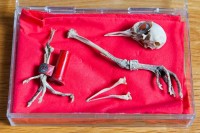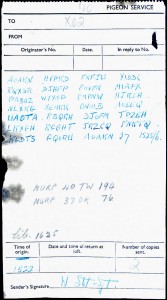 The United Kingdom’s Government Communications Headquarters (GCHQ), the British government’s code-breaking unit, has officially given up on cracking the coded message carried by a pigeon whose remains were found in a chimney in Surrey in 1982. GCHQ only began working on the message last month after curators at the Bletchley Park museum spent two years trying to decipher it but were unable to make any headway. When the story first made the news at the beginning of November, GCHQ said they wouldn’t comment on it until the code was broken. Now they’ve released an official statement in which they throw their hands up.
The United Kingdom’s Government Communications Headquarters (GCHQ), the British government’s code-breaking unit, has officially given up on cracking the coded message carried by a pigeon whose remains were found in a chimney in Surrey in 1982. GCHQ only began working on the message last month after curators at the Bletchley Park museum spent two years trying to decipher it but were unable to make any headway. When the story first made the news at the beginning of November, GCHQ said they wouldn’t comment on it until the code was broken. Now they’ve released an official statement in which they throw their hands up.
During the war, the methods used to encode messages naturally needed to be as secure as possible and various methods were used. The senders would often have specialist codebooks in which each code group of four or five letters had a meaning relevant to a specific operation, allowing much information to be sent in a short message. For added security, the code groups could then themselves be encrypted using, for example, a one-time pad.
The message found at Bletchingley had 27 five-letter code groups, and the GCHQ experts believe its contents are consistent with this method. This means that without access to the relevant codebooks and details of any additional encryption used, it will remain impossible to decrypt. […]
The basis of a “one-time pad” encryption system is that a random key is used to encrypt (and subsequently decrypt) only one message. The advantage of this system is that, if used correctly, it is unbreakable as long as the key is kept secret. The disadvantage is that both the sending and receiving parties need to have access to the same key, which usually means producing and sharing a large keypad in advance.
 They’d have more of a chance if they could find out more about the pigeon, its destination “X02” and its sender “Sjt W Stot” because it would narrow down the potential codebooks used. However, they still don’t know what “X02” refers to and haven’t been able to locate a “Sjt W Stot” in the records or a pigeon with either of the code numbers listed in the message. Colin Hill, curator of Bletchley Park’s war pigeons exhibition, is still working on tracking down the pigeon.
They’d have more of a chance if they could find out more about the pigeon, its destination “X02” and its sender “Sjt W Stot” because it would narrow down the potential codebooks used. However, they still don’t know what “X02” refers to and haven’t been able to locate a “Sjt W Stot” in the records or a pigeon with either of the code numbers listed in the message. Colin Hill, curator of Bletchley Park’s war pigeons exhibition, is still working on tracking down the pigeon.
There is a very slim chance that a surviving World War II veteran might have saved a codebook or two or might be able to identify Sjt Stot and X02. This BBC article includes a contact form at the end for people who have any information or ideas on how to crack the code to submit their ideas. The Telegraph is asking people to email them their solutions. The sender of the best suggestion will win a crossword book.
GCHQ clearly thinks it’s a futile enterprise. They entitled the press release “Pigeon takes secret message to the grave” and include a tribute to the genius of the war-time coders who created encryption methods that could not be broken decades later with all the fancy technology in the world. A GCHQ historian known only as Tony told the BBC that “the most helpful suggestion we had through all of this was from a member of the public who suggested that, since the message was found in the chimney, the first two words were most likely to be ‘Dear Santa’.” No need to be a smartass, Mr. Secret Agent Man, just because you can’t crack a 70-year-old code.
Mr Secret Agent -Historian- Man! 🙂 I’m glad that the public now has the chance to have a go at this coded message. It’ll be interesting to see what happens!
It would be unsettling if a German WWII veteran could decrypt the message.
It will be more unsettling if Santa finds out someone’s reading his mail.
I think that GCHQ can actually decypher the message but is just not willing to share the it with the rest of the world… for the sake of National Security, of course! :confused:
I wish! My fear is that they just don’t give a crap. They only worked on it for a month and they’re already giving up and making lame Santa Claus cracks. 🙁
I was a US NAVY Radioman MORSE CODE CW operator
during the Korean, cold war, and Vietnam confilct. That message was typical of what I
copied and sent to our crytographers for decryption. It seems to me that if there is a
date and time on that message, it could be
deciphered by cryto machines used at that time.
Those machines must still be available some where and kept for historical value. Check with
the old timers who were active crptographes dduring that period.
The code was examined at the Bletchley Park museum, home of many extant cryptographic machines, for two years with no success. Unless they can find the person who sent it, his location, the destination and the specific codebooks used, I’m afraid there is no chance of cracking that code.
looks like sent from Bremen confluence: 8 degrees 52′ 22′ east
code key 040105 ACD
Woot!
“It’s a real coo as ‘unbreakable’ war code found on pigeon in Portland is cracked”
http://www.dorsetecho.co.uk/news/10110584.It_s_a_real_coo_as__unbreakable__war_code_found_on_pigeon_in_Portland_is_cracked/
JGHBY NUSHO MANSI RYZCT
JGHBY NUSHO MANSU RYZCT
Poem of Mansur?